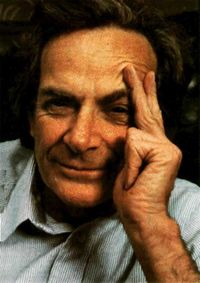Chapter 1. Introduction
1.1. The Impact of the Scientific Revolution: A Brief History of the Experimental Method in the 17th Century*
Lauren Ames, Jo Kent, Amneet Gulati, Adam Purtee
Faculty Sponsor: Christopher Kelty, Rice University Department of Anthropology
The Impact of the Scientific Revolution: A Brief History of the Experimental Method in the 17th Century
The American statesman Adlai Stevenson once said, America “can chart our future clearly and wisely only when we know the path which has led to the present.” [1]This is clearly true in the field of science and research. Today, as scientists experiment with nanotechnology and venture into a wide variety of new scientific disciplines, it remains important to take a look back to the origins of scientific discovery and understand some of the events that have shaped the world of science, and, more importantly, to realize how science behaves as an evolving process.
Introduction
The beginning of the seventeenth century is known as the “scientific revolution” for the drastic changes evidenced in the European approach to science during that period. The word “revolution” connotes a period of turmoil and social upheaval where ideas about the world change severely and a completely new era of academic thought is ushered in. This term, therefore, describes quite accurately what took place in the scientific community following the sixteenth century. During the scientific revolution, medieval scientific philosophy was abandoned in favor of the new methods proposed by Bacon, Galileo, Descartes, and Newton; the importance of experimentation to the scientific method was reaffirmed; the importance of God to science was for the most part invalidated, and the pursuit of science itself (rather than philosophy) gained validity on its own terms. The change to the medieval idea of science occurred for four reasons: (1) seventeenth century scientists and philosophers were able to collaborate with members of the mathematical and astronomical communities to effect advances in all fields; (2) scientists realized the inadequacy of medieval experimental methods for their work and so felt the need to devise new methods (some of which we use today); (3) academics had access to a legacy of European, Greek, and Middle Eastern scientific philosophy they could use as a starting point (either by disproving or building on the theorems); and (4) groups like the British Royal Society helped validate science as a field by providing an outlet for the publication of scientists’ work. These changes were not immediate, nor did they directly create the experimental method used today, but they did represent a step toward Enlightenment thinking (with an emphasis on reason) that was revolutionary for the time. Assessment of the state of science before the scientific revolution, examination of the differences in the experimental methods utilized by different “scientists” during the seventeenth century, and exploration into how advances made during the scientific revolution affected the scientific method used in science today will provide an idea of how revolutionary the breakthroughs of the seventeenth century really were and what impact they’ve had.
Science and Philosophy Before the Revolution
In immediate contrast to modern times, only a few of Europe’s academics at the beginning of the scientific revolution and the end of the sixteenth century considered themselves to be “scientists.” The words “natural philosopher” carried much more academic clout and so the majority of the research on scientific theory was conducted not in the scientific realm per se, but in philosophy, where “scientific methods” like empiricism and teleology were promoted widely. In the 17th century, empiricism and teleology existed as remnants of medieval thought that were utilized by philosophers such as William of Ockham, an empiricist (d. 1349), Robert Boyle (Hall, p 172), a 17th century chemist, teleologist and mechanist, and by the proponents of Plato and Aristotle (1st century teleologists and abstractionists). Both empiricism, as the theory that reality consists solely of what one physically experiences, and teleology, as the idea that phenomena exist only because they have a purpose (i.e. because God wills them to be so), generally negated the necessity of fact-gathering, hypothesis writing, and controlled experimentation that became such an integral part of modern chemistry and biology at the beginning of the 17th century. In other words, the study of science before the scientific revolution was so concentrated on philosophy (such as Aristotle’s conception of “ideas” as ultimate truths) as to preclude the development of a scientific method that would necessitate the creation of an informed hypothesis to be tested. Certain medieval philosophers, however, such as Roger Bacon (1214-1294; no relation to Francis), did emphasize the necessity of controlled experimentation in coming to a theoretical conclusion, but they were few and far between, and generally failed to correctly use the experimental method in practice. For example, author Hall wrote that “Bacon [and other advocates were] guilty of misstatements of fact which the most trifling experiment would have corrected” (Hall, p 163).
The Advent of the Scientific Revolution – 17th Century
A. R. Hall, in his book The Scientific Revolution 1500-1800, made the observation that a main point dividing scientific thought in the seventeenth century from that of the ancient Greeks and medieval Europeans was the choice of questions each group sought to answer through their methods of research or observation. [2]He argued that the first group, that of Copernicus and da Vinci (15th and 16th centuries), focused more on questions of “how can we demonstrate that…” or “how may it be proved that…” that aimed to prove a defined hypothesis true or false, while the second group (that of 17th century chemists and physiologists) emphasized questions phrased as “what is the relationship between…” or “what are the facts bearing upon…” that necessitated fact-finding before a concrete hypothesis could be formulated. The most important point to remember here is that both the questions posed in the 15th century and those of the 17th century form part of the definition of a complete modern “experimental method” – the first type of question cannot stand alone. A concrete hypothesis (question 1) must be accompanied by sufficient, independently verifiable observations (question 2) in order for the scientist to make a vague inference (a form of hypothesis) that can then be tested with a controlled experiment. The way the scientist/philosopher comes by this “vague inference” that will form a concrete hypothesis differs, and these differences can be described as the scientists’ different approaches toward an “experimental method.” The following portion of the module will give an idea of the types of experimental methods promoted by 17th century scientists as well as their impact on the standard experimental method utilized and accepted by chemists, biologists, and physicists today.
Case Studies of Scientists and Their “Experimental Methods”
Francis Bacon (1561-1626): Bacon represents a first step away from sixteenth century thinking, in that he denied the validity of empiricism (see introduction) and preferred inductive reasoning (the method of deriving a general “truth” from observation of certain similar facts and principles) to the Aristotelian method of deductive reasoning (the method of using general principles to explain a specific instance, where the particular phenomena is explained through its relation to a “universal truth”). Moreover, like Roger Bacon of the 13th century, Francis Bacon argued that the use of empiricism alone is insufficient, and thus emphasized the necessity of fact-gathering as a first step in the scientific method, which could then be followed by carefully recorded and controlled (unbiased) experimentation. Bacon largely differed from his sixteenth century counterparts in his insistence that experimentation should not be conducted to simply “see what happens” but “as a way of answering specific questions.” Moreover, he believed, as did many of his contemporaries, that a main purpose of science was the betterment of human society and that experimentation should be applied to hard, real situations rather than to Aristotelian abstract ideas. His experimental method of fact-gathering largely influenced advances in chemistry and biology through the 18th century. [3]
Galileo Galilei (1564-1642): Galileo’s experimental method contrasted with that of Bacon in that he believed that the purpose of experimentation should not simply be a means of getting information or of eliminating ignorance, but a means of testing a theory and of testing the success of the very “testing method.” Galileo argued that phenomena should be interpreted mechanically, meaning that because every phenomenon results from a combination of the most basic phenomena and universal axioms, if one applies the many proven theorems to the larger phenomenon, one can accurately explain why a certain phenomenon occurs the way it does. In other words, he argued that “an explanation of a scientific problem is truly begun when it is reduced to its basic terms of matter and motion,” because only the most basic events occur because of one axiom.
For example, one can demonstrate the concept of “acceleration” in the laboratory with a ball and a slanted board, but to fullyexplain the idea using Galileo’s reasoning, one would have to utilize the concepts of many different disciplines: the physics-based concepts of time and distance, the idea of gravity, force, and mass, or even the chemical composition of the element that is accelerating, all of which must be individually broken down to their smallest elements in order for a scientist to fully understand the item as a whole. This “mechanic” or “systemic” approach, while necessitating a mixture of elements from different disciplines, also partially removed the burden of fact-gathering emphasized by Bacon. In other words, through Galileo’s method, one would not observe the phenomenon as a whole, but rather as a construct or system of many existing principles that must be tested together, and so gathering facts about the performance of the phenomenon in one situation may not truly lead to an informed observation of how the phenomenon would occur in a perfect circumstance, when all laws of matter and motion come into play. Galileo’s abstraction of everything concerning the phenomenon except the universal element (e.g. matter or motion) contrasted greatly with Bacon’s inductive reasoning, but also influenced the work of Descartes, who would later emphasize the importance of simplification of phenomena in mathematical terms. Galileo’s experimental method aided advances in chemistry and biology by allowing biologists to explain the work of a muscle or any body function using existing ideas of motion, matter, energy, and other basic principles.
René Descartes (1596-1650):Descartes disagreed with Galileo’s and Bacon’s experimental methods because he believed that one could only:
“(1) Accept nothing as true that is not self-evident. (2) Divide problems into their simplest parts. (3) Solve problems by proceeding from simple to complex. (4) Recheck the reasoning.” [4]That these “4 laws of reasoning” followed from Descartes’ ideas on mathematics (he invented derivative and integral calculus in order to better explain natural law) gives the impression that Descartes, like many 17th century philosophers, were using advances in disciplines outside philosophy and science to enrich scientific theory. Additionally, the laws set forth by Descartes promote the idea that he trusted only the fruits of human logic, not the results of physical experimentation, because he believed that humans can only definitely know that “they think therefore they are.” Thus, according to Descartes’s logic, we must doubt what we perceive physically (physical experimentation is imperfect) because our bodies are external to the mind (our only source of truth, as given by God). [5]Even though Descartes denounced Baconian reasoning and medieval empiricism as shallow and imperfect, Descartes did believe that conclusions could come about through acceptance of a centrifugal system, in which one could work outwards from the certainty of existence of mind and God to find universal truths or laws that could be detected by reason. [6]It was to this aim that Descartes penned the above “4 laws of reasoning” – to eliminate unnecessary pollution of almost mathematically exact human reason.
Robert Boyle (1627-1691):
Boyle is an interesting case among the 17th century natural philosophers, in that he continued to use medieval teleology as well as 17th century Galilean mechanism and Baconian induction to explain events. Even though he made progress in the field of chemistry through Baconian experimentation (fact-finding followed by controlled experimentation), he remained drawn to teleological explanations for scientific phenomena. For example, Boyle believed that because “God established rules of motion and the corporeal order – laws of nature,” phenomena must exist to serve a certain purpose within that established order. Boyle used this idea as an explanation for how the “geometrical arrangement of the atoms defined the chemical characteristics of the substance.” [7]Overall, Boyle’s attachment to teleology was not so strange in the 17th century because of Descartes’ appeal to a higher being as the source of perfection in logic.
Hooke (1635-1703):
Hooke, the Royal Society’s first Curator of Experiments from 1662-1677, considered science as way of improving society. This was in contrast to medieval thought, where science and philosophy were done for knowledge’s sake alone and ideas were tested just to see if it could be done. An experimentalist who followed the Baconian tradition, Hooke agreed with Bacon’s idea that “history of nature and the arts” was the basis of science. [8]He was also a leader in publicizing microscopy (not discovering, it had been discovered 30 years prior to his Micrographia).
Sir Isaac Newton (1643-1747):
Newton invented a method that approached science systematically. He composed a set of four rules for scientific reasoning. Stated in the Principia, Newton’s four way framework was: “(1) Admit no more causes of natural things such as are both true and sufficient to explain their appearances, (2) The same natural effects must be assigned to the same causes, (3) Qualities of bodies are to be esteemed as universal, and (4) Propositions deduced from observation of phenomena should be viewed as accurate until other phenomena contradict them.” [9]His analytical method was a critical improvement upon the more abstract approach of Aristotle, mostly because his laws lent themselves well to experimentation with mathematical physics, whose conclusions “could then be confirmed by direct observation.” Newton also refined Galileo’s experimental method by creating the contemporary “compositional method of experimentation” that consisted in making experiments and observations, followed by inducted conclusions that could only be overturned by the realization of other, more substantiated truths. [10]Essentially, through his physical and mathematical approach to experimental design, Newton established a clear distinction between “natural philosophy” and “physical science.”
All of these natural philosophers built upon the work of their contemporaries, and this collaboration became even simpler with the establishment of professional societies for scientists that published journals and provided forums for scientific discussion. The next section discusses the impact of these societies, especially the British Royal Society.
The Role of the Royal Society
Along with the development of science as a discipline independent from philosophy, organizations of scholars began to emerge as centers of thought and intellectual exchange. Arguably the most influential of these was the Royal Society of London for the Improvement of Natural Knowledge (from official website http://www.royalsocac.uk/page.asp?id=2176), which was established in 1660 with Robert Hooke as the first Curator of Experiments. Commonly known as the Royal Society, the establishment of this organization was closely connected with the development of the history of science from the seventeenth century onwards. [11]The origins of the Royal Society grew out of a group of natural philosophers (later known as "scientists") who began meeting in the mid-1640s in order to debate the new ideas of Francis Bacon. The Society met weekly to witness experiments and discuss what we would now call scientific topics. A common theme was how they could learn about the world through experimental investigation.
The academy became an indispensable part of the development of modern science because in addition to fostering discussing among scientists, the Royal Academy became the de facto academy for scientific study in Europe. Accomplished scientists served as Royal Academy Fellows and exchanged ideas both casually and formally through the publication of articles and findings. These scholars, especially Francis Bacon, served as an important resource for the justification of the new fact-gathering, experiment-based experimental method as well as for the validation of "modern (17th century) science." Moreover, the work they published through the society helped gain credibility for the society and for science as a discipline. For example, scholars such as Robert Boyle published significant scientific findings in its unofficial journal Philosophical Transactions (Dear, p 140). Other famous scientists that joined the society included Robert Boyle, Isaac Newton and William Petty, all of whom benefited from academic collaboration within the society and from increased publicity generated by their published works.
Dedicated to the free exchange of scientific information, the Royal Society of London - and later, its counterparts throughout Europe such as The Hague and the Academy of Sciences in Paris - proved crucial to the discussion and design of modern science and the experimental method. Although the Royal Society was a governmentally established body, it acted independently as a body dedicated to research and scientific discovery - that is to say, to improving knowledge and integrating all kinds of scientific research into a coherent system. With such a central artery for scientific progress, scientists were able to more quickly and fiercely support and promote their new ideas about the world.
Conclusion
The defining feature of the scientific revolution lies in how much scientific thought changed during a period of only a century, and in how quickly differing thoughts of different natural philosophers condensed to form a cohesive experimental method that chemists, biologists, and physicists can easily utilize today. The modern experimental method incorporates Francis Bacon's focus on use of controlled experiments and inductive reasoning, Descartes' focus on hypothesis, logic, and reason, Galileo's emphasis on incorporation of established laws from all disciplines (math, astronomy, chemistry, biology, physics) in coming to a conclusion through mechanism, and Newton’s method of composition, with each successive method strengthening the validity of the next. Essentially, the scientific revolution occurred in one quick bound and the advances made from the 17th century onward appear as little skips in comparison.
However, one must keep in mind that although the Greeks and the philosophers of the 17th century invented and began to perfect the experimental method, their outcomes in their experiments were often flawed because they didn't follow their own advice. Even philosophers like Francis Bacon, the main promoter of fact-gathering and controlled experimentation failed at some point in time to control their experiments or use peer review, or used too much inference/logic and too little mathematic proof/experiment. In short, scientists today must learn from the mistakes of the 17th century philosophers like Galileo who wrote so eloquently about the necessity of a successful scientific method but didn’t execute it correctly or failed to recognize the importance of pursuing scientific progress not simply for theoretical excellence, but for how it can improve the human condition.
The lesson to take from the history of the scientific revolution is that the ideas of the17th century philosophers have the most impact in the context of the progress they made as an academic whole – as singular scientists, they became more prone to faulty logic and uncontrolled experimentation. For instance, non-scientific reasoning such as teleology continued to affect genius philosophers and scientists such as Descartes and Boyle, and today scientists are faced with the problem of intelligent design (teleology) being taught as the equivalent of peer-reviewed, substantiated evolutionary theory. Overall, modern scientists remain just as proneto the same problems as the 17th century philosophers and therefore might consider looking toward the legacy of the successes of the scientific revolution against the backward medieval philosophy for guidance.
Works Cited
1. "About the Society." The Royal Society 2005. The Royal Society. 15 Nov. 2005 <http://www.royalsoc.ac.uk/page.asp?id=2176>.
2. Dear, Peter. Revolutionizing the Sciences: European Knowledge and Its Ambitions,
1500-1700. Princeton: Princeton University Press, 2005.
3. Francis Bacon. Farlex, Inc. The Free Dictionary 16 Nov. 2005 <http://img.tfd.com/authors/bacon.jpg>.
4. Galileo Galilei. NASA. 16 Nov. 2005 <http://antwrp.gsfc.nasa.gov/apod/ap980913.html>.
5. Hall, A R. The Scientific Revolution 1500-1800: The formation of the Modern Scientific Attitude. London and Colchester: Longmans, Green and Co, 1954.
6. Hellyer, Marcus. The Scientific Revolution. Oxford: Blackwell Publishing Ltd, 2003.
7. Isaac Newton. Université de Nantes. Sciences - Université de Nantes. 16 Nov. 2005 <http://www.sciences.univ-nantes.fr/physique/enseignement/tp/hist/newton.jpg>.
8. René Descartes Free Online Library by Farlex. 16 Nov. 2005 <http://descartes.thefreelibrary.com/>.
9. "Robert Boyle." 15 Nov. 2005 <http://dbhs.wvusd.k12.ca.us/webdocs/GasLaw/Gas-Boyle-Data.html>.
10. Robert Hooke. NNDB. 15 Nov. 2005 <http://www.nndb.com/people/356/000087095/robert-hooke-1.jpg>.
1.2. Government-Funded Science: Vannevar Bush and the National Science Foundation*
Note
This module was developed as part of a Rice University Class called "Nanotechnology: Content and Context" initially funded by the National Science Foundation under Grant No. EEC-0407237. It was conceived, researched, written and edited by students in the Fall 2005 version of the class, and reviewed by participating professors.
Before the Birth of the National Science Foundation
Prior to the Civil War and the subsequent industrialization of America the principal public uses made of science were of an ad hoc nature. Only when absolutely necessary were science and policy to intertwine. By the time of the Civil War the scientific profession had undergone an obvious transformation as science became increasingly specialized. In 1863 the National Academy of Sciences was founded by Congress at the insistence of scientists both in and out of government. The academy was created as a self-perpetuating body of scientists charged with investigating various fields of science when called upon to do so by the government.
The victory of the North further allowed for the “general welfare” and the freer hand of the federal government permitted an expansion of permanent scientific agencies. The establishment of agricultural institutions and consequently other government agencies such as the National Bureau of Standards (1901), the Public Health Services (1912), and the National Advisory Committee for Aeronautics (1915). Slowly it was becoming obvious that science had a wide-ranging impact on government apart form any immediate usefulness and that through regulation it frequently provided the lead in the growing interrelation of the public and private sectors of the economy. The threat of WWI meant that research and development in the field of weaponry would be necessary in case of any involvement. A second world war would completely change this lack of initiative and interest.
World War II marked the beginning of a new era for American science as the emergence of “science policy” produced a significant role for science and technology in public affairs. Long before WWII scientific inquiry was nurtured almost entirely by private patronage and philanthropic efforts and it was not until mass consensus was reached that the government found itself in the necessity of funding and consequently controlling scientific practices and research. With the war experience science had proven itself indispensable to the government and a close partnership of some kind between the two was soon to emerge. The time had come to think about what large-scale scientific research meant for American society and democracy. The American research system began to take shape as the nation moved from demobilization to reconstruction of the world economy to stable prosperity, and from Cold War tensions to the Korean War to protracted superpower rivalry.
“One of our hopes is that after the war there will be full employment. To reach that goal the full creative and productive energies of the American people must be released. To create more jobs we must make new and better and cheaper products… These products are founded on new principles and new conceptions which in turn result from basic scientific capital. Moreover, we cannot any longer depend upon Europe as a major source of science capital.”Smith, 70 [link]
*All quotes in this section are taken from Bush [link]
The period immediately after World War II was one of boundless enthusiasm for the power of science in the United States. New technologies had been essential to success in the war and both the government and public were optimistic about science’s potential during peacetime. It was such that in November 1944–before the war was officially over–President Franklin D. Roosevelt asked the Director of the Office of Scientific Research and Development, Vannevar Bush, to write a report on how the rapid scientific progress seen during wartime could be continued. Bush exemplified the idealistic view of science in his response eight months later–while the fight was ongoing in the Pacific.
The title of the Director’s document, Science: The Endless Frontier, was the first clue of the nature of its content. The second was a quote that introduces the report, taken from President Roosevelt’s request letter,
"New frontiers of the mind are before us, and if they are pioneered with the same vision, boldness, and drive with which we have waged this war we can create a fuller and more fruitful employment and a fuller and more fruitful life.”
Bush supported the attitude that science will lead society down this path by citing the crucial role it played in World War II. “In this war it has become clear beyond all doubt that scientific research is absolutely essential to national security.” With the war fresh in the public conscience–indeed, it was ongoing–this was an important point. Penicillin prevented “incalculable suffering” and saved “countless lives.” Radar was essential in winning the “battle of scientific techniques” against Nazi Germany. Still, Bush realized science offered enticing potential in peaceful areas as well, for it had given rise to a dramatic increase in quality of life. Millions were employed in industries created by scientific advancements. Again calling attention to a national concern of the time, he referred specifically to progress in agriculture.
Bush’s language in describing these accomplishments was important, for he characterized “science” as an abstract entity that was independent of human intervention. For example, with respect to the millions of new jobs, he wrote, “Science made that possible.” Still, he explicitly stated that this entity was not a self-supporting solution–“Science, by itself, provides no panacea for individual, social, and economic ills”–but that it is an essential part–“without scientific progress no amount of achievement in other directions can insure our health, prosperity, and security as a nation in the modern world.” In other words, the Director was communicating the view that science was not a result of human ingenuity, but an independent entity that must be exploited.
This attitude contributed to Bush’s emphasis on the importance of basic research. In order to take advantage of science, one must have “an understanding of nature and its laws” (provided by basic research) which can then be applied to practical applications. The Director noted that the primary goal of industry was the development of new products, not new knowledge. The radio was developed because of knowledge in electromagnetic radiation, which was discovered by an earlier group with unrelated intentions.
The report had established the premise that science was essential to national development, most notably in security and medicine. In addition, basic research was necessary for sustained scientific advancement. From this, Bush proposed measures to ensure that progress continued and supported them by affirming the President’s view that science would lead the nation closer to a utopia. In the Director’s own words
“Advances in science when put to practical use mean more jobs, higher wages, shorter hours, more abundant crops, more leisure for recreation, for study, for learning how to live without the deadening drudgery which has been the burden of the common man for ages past. Advances in science will also bring higher standards of living, will lead to the prevention or cure of diseases, will promote conservation of our limited national resources, and will assure means of defense against aggression.”
Bush clearly perceived science as a key that would solve countless ills. Again, science was a separate entity containing all the answers and “the limiting factor is a human one.” His argument was that the government must give society all available means to pursue scientific research and unlock the endless potential available. Bush wrote that basic research especially needed continuous federal support because it was not economically profitable by itself. Only then could technological advances be sustained.
General Recommendations Regarding Science Policy*
In his letter, Science: The Endless Frontier, Vannevar Bush applauded the government’s support of directly useful, applied research. However, he also memorably stated that “we have been living off our fat” with respect to research, maintaining that immediately applicable studies were not enough, and that the nation needed to redefine its public pursuit of scientific knowledge with an emphasis on continued basic research. In addition to increased public funding for such research, Bush called for the raising of standards for recruitment of scientific personnel, as it was not, to his view, competing adequately with industry for scientific expertise.
Industrial research was negatively affected by ambiguity of income tax laws with regard to deductions for research expenses; it was therefore suggested that the legislation be clarified to make clear the advantages of research and development for industry. Bush also pointed out the opacity of patent law, and its similarly detrimental effect on industrial research.
Bush recognized the existing governmental scientific bureaus and departments as basically fixed, but he emphasized a need for an impartial liaison between the legislative and executive branches and these departments. In his letter, this idea took the form of a “Science Advisory Board” “composed of disinterested scientists who have no connection with the affairs of any Government agency.”
In the post-World War II era, most of a generation of student-aged men had been taken from their studies or work to serve in the military. This created a gap in the pure science personnel of the country, in addition to a steep dropout rate in higher education. Bush noted that college training was limited to the higher socio-economic classes, but talent was not. He advocated national and state-funded scholarships and fellowships for science study, and further suggested that in return, these people should answer the government’s call in times of need as part of a National Science Reserve.
Bush’s Vision of the National Science Foundation*
Bush strongly advocated the formation of a unified agency for the funding and coordination of basic research; in his letter, he described science as “fundamentally a unitary thing,” one whose advancement is hampered by compartmentalization. The various scientific disciplines are interdependent, and so Bush wished to keep their regulatory separation to a minimum. The entire conception of the functioning of the National Science Foundation centered around what he called the “five fundamentals:”
Stability of funds dispersed over long periods of time. Unlike applied research and development, basic research has little surety of when (or if) it will produce useful and/or marketable results. Funding must be consistent despite this uncertainty in order for basic research to have a chance at uncovering important knowledge.
The administration of funding by “citizens selected only on the basis of their interest in and capacity to promote the work of the agency.”
Assistance of research by funding projects outside the Federal Government; the agency “should not operate any laboratories of its own.” This provision promotes freedom of researchers, and seeks to avoid bias of funding toward labs and projects in which the agency itself has direct interest.
Private colleges, universities, and other institutions receiving funding should be given free reign for “internal control of policy, personnel, and the method and scope of the research.”
Responsibility to the President and Congress. Standard government procedures of auditing, budgeting, etc. are to be applied to the agency, with leeway for any necessary adjustment due to the special nature of research as opposed to other federally-funded activities.
In addition to funding research, the National Science Foundation (or, as Bush termed it in Science: The Endless Frontier, the National Research Foundation), was to promote science education, furnishing scholarships mentioned in the section above. Bush also saw a need for international sharing of scientific research, and intended for the NSF to oversee and facilitate this.
Fulfilling the second of the “five fundamentals” listed above, the NSF was to be headed by nine Members not affiliated with the government in any way save through the NSF, and these Members would elect a chairman on a yearly basis. The Members would also appoint a salaried director for the “fiscal, legal, and administrative functions of the Foundation.” Bush initially suggested five Divisions for the NSF that would make recommendations of policy and funding in their particular zones of research, and would be responsible for review of the research quality in the particular division:
Division of Medical Research
Division of Natural Sciences
Division of Scientific Personnel and Education (dealing with the dispersal of grants and scholarships)
Division of Publications and Scientific Collaboration (“encouraging the publication of scientific knowledge and promoting international exchange of scientific information”)
Division of National Defense – This division is distinct from various military projects in applied research such as weapon development; it is intended to be composed of civilian scientists only. Bush saw a need for sustained, long-range research pertaining to defense above and beyond immediate, wartime concerns, and felt that civilian researchers were best equipped to carry this out.
Each division would, under this system, have its own set of Members answerable to the Members of the Foundation. The Foundation Members would hold the regulatory power of the Foundation, making rules of policy, managing the flow of funding, working with other government bureaus and agencies if necessary, and assisting the flow of scientific information on the international stage.
The ultimate emphasis in this idea of a National Science Foundation is placed on creating an environment of intellectual freedom for private researchers to the greatest extent possible, because Bush believed this was the key to productivity and advances in science. Cutting the financial strings of industry from the limbs of scientists in this way was to free them to make the oft-unexpected advances in basic science that may come to revolutionize the world.
Realization of the National Science Foundation
In the case of the National Science Foundation, which was to implement the recommendations for basic research support made in the Bush and Steelman Reports, controversy raged over the relation of the proposed agency to the presidency. Should it be headed by an independent group of scientist-commissioners or by an administrator appointed by the President? Five years later the NSF finally emerged in 1950 with a presidentially appointed director and a board of part-time scientists with veto-power over awarding of research grants.Smith, 6 [link] By the early 1960s Congress had taken the full plunge into science policy rewriting the NSF’s charter, creating new NIH institutes, and unsuccessfully attempting to establish a central Department of Science.
Currently operating with an annual budget of about $5.5 billion, the NSF is the major funding source for approximately 20 percent of all federally supported basic research conducted by America's colleges and universities. In many fields such as mathematics, computer science and the social sciences, NSF is the major source of federal funding.
NSF leadership has evolved to be comprised of two major components: a director who oversees NSF staff and management responsible for program creation and administration, merit review, planning, budget and day-to-day operations; and a 24-member National Science Board (NSB) of eminent individuals that meets six times a year to establish the overall policies of the foundation. The director and all Board members serve six year terms. They are all, including the NSF deputy director, appointed by the President of the United States and confirmed by the U.S. Senate. Presently the NSF has a total workforce of about 1,700 at its headquarters in Arlington, VA. This includes approximately 1200 career employees, 150 scientists from research institutions on temporarily employed, and approximately 200 contract workers.
“NSF operates from the "bottom up," keeping close track of research around the United States and the world, maintaining constant contact with the research community to identify ever-moving horizons of inquiry, monitoring which areas are most likely to result in spectacular progress and choosing the most promising people to conduct the research.”National Science Foundation
References
Bush, Vannevar (Ed.). (1945). Science: The Endless Frontier. United States Office of Scientific Research and Development. Washington, DC: United States Government Printing Office.
Dupre and Lakoff. (1962). Science and the Nation: Policy and Politics. Englewood Cliffs, NJ: Prentice Hall Inc.
Guston, David H. (2000). Between Politics and Science. Cambridge, UK: Cambridge University Press.
Rothenberg, Marc (Ed.). (2001). History of Science in the United States- An Encyclopedia. New York, NY: Garland Publishing Co.
Smith, Bruce. (1990). America Science Policy Since World War II. Washington, DC: The Brookings Institution.
Wiesner, Jerome B. (1961). Where Science and Politics Meet. New York, NY: McGraw Hill Book Company.
1.3. The Early History of Nanotechnology*
Note
"This module was developed as part of a Rice University Class called "Nanotechnology: Content and Context" initially funded by the National Science Foundation under Grant No. EEC-0407237. It was conceived, researched, written and edited by students in the Fall 2005 version of the class, and reviewed by participating professors."
Introduction
Nanotechnology is an essentially modern scientific field that is constantly evolving as commercial and academic interest continues to increase and as new research is presented to the scientific community. The field’s simplest roots can be traced, albeit arguably, to 1959 but its primary development occurred in both the eighties and the early nineties. In addition to specific scientific achievements such as the invention of the STM, this early history is most importantly reflected in the initial vision of molecular manufacturing as it is outlined in three important works. Overall, an understanding of development and the criticism of this vision is integral for comprehending the realities and potential of nanotechnology today.
Richard Feynman: There's Plenty of Room at theBottom, 1959
"But I am not afraid to consider the final question as to whether, ultimately---in the great future---we can arrange the atoms the way we want; the very atoms, all the way down!" -Richard Feynman, There's Plenty of Room at the Bottom
The first time the idea of nanotechnology was introduced was in 1959, when Richard Feynman, a physicist at Caltech, gave a talk called "There's Plenty of Room at the Bottom." Though he never explicitly mentioned "nanotechnology," Feynman suggested that it will eventually be possible to precisely manipulate atoms and molecules. Moreover, in an even more radical proposition, he thought that, in principle, it was possible to create "nano-scale" machines, through a cascade of billions of factories. According to the physicist, these factories would be progressively smaller scaled versions of machine hands and tools. He proposed that these tiny "machine shops" would then eventually be able to create billions of tinier factories.[1] In these speculations, he also suggested that there are various factors, which uniquely affect the nano-scale level. Specifically, he suggested that as the scale got smaller and smaller, gravity would become more negligible, while both Van Der Waals attraction and surface tension would become very important. In the end, Feynman's talk has been viewed as the first academic talk that dealt with a main tenet of nanotechnology, the direct manipulation of individual atoms (molecular manufacturing).[2]
"The revolutionary Feynman vision launched the global nanotechnology race."-Eric Drexler
Hence, long before STMs and atomic force microscopes were invented Feynman proposed these revolutionary ideas to his peers. As demonstrated in his quote (above), he chose to deal with a "final question" that wasn't fully realized till the eighties and nineties. Ultimately then, it was during these two decades, when the term "nanotechnology" was coined and researchers, starting with Eric Drexler, built up this field from the foundation that Feynman constructed in 1959. However, some such as Chris Toumey minimize the importance of Feynman in the establishment of the intellectual groundwork for nanotechnology.[3] Instead, using evidence from its citation history, Toumey sees "There's Plenty of Room at the Bottom" as a "founding myth" that served only to directly influence Drexler rather than the other important scientists, who affected the future development of nanotechnology. Nevertheless, though the ultimate effect of Feynman's talk is debatable, it is certain that this work directly influenced Drexler's own research, which thus indirectly influenced nanotechnology as a whole.
Eric Drexler: "Molecular Manufacturing," 1981
Figure 1.2.
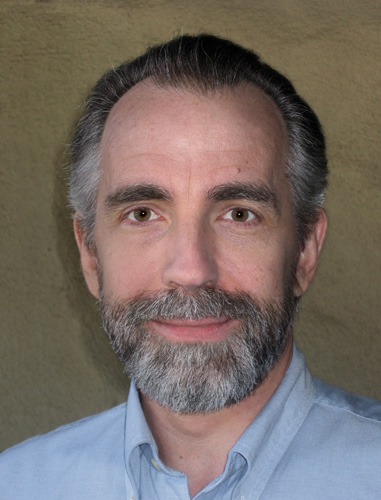
In 1979, Eric Drexler encountered Feynman's talk on atomic manipulation and "nano-factories." The Caltech physicist's ideas inspired Drexler to put these concepts into motion by expanding Feynman's vision of molecular manufacturing with contemporary developments in understanding protein function. From this moment, Drexler's primary goal was to build upon the physicist's revolutionary foundation. As a result, though the term was yet to be coined, the field of nanotechnology was created.[4]
Figure 1.3.
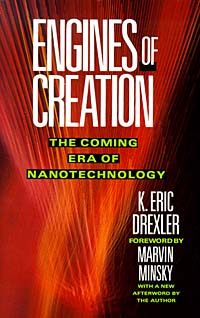
In 1981, Drexler published his first article on the subject in the prestigious scientific journal, Proceedings of the National Academy of Sciences. Titled "Molecular engineering: An approach to the development of general capabilities for molecular manipulation," Drexler's publication essentially expanded the idea of molecular manufacturing by integrating modern scientific ideas with Feynman's concepts.[5] Hence, he established his own vision of molecular manufacturing in this paper. Specifically, in his abstract, he discusses the possibility of molecular manufacturing as a process of fabricating objects with specific atomic specifications using designed protein molecules. He suggests that this would inevitably lead to the design of molecular machinery that would be able to position reactive groups with atomic precision.[6] Thus, Drexler states that molecular manufacturing and the construction of "nano-machines" is a product of an analogous relationship "between features of natural macromolecules and components of existing machines."[7] In addition, Drexler includes a table that outlines by function the molecular equivalents to macroscopic technologies. For example, he believed that bearings, which provide support for moving parts, are analogous to Sigma bonds. Overall, generating some interest in the scientific community, this publication presented Drexler's initial vision of molecular manufacturing, which was ultimately influenced by Feynman's talk. As a result, the field of nanotechnology continued to evolve, for Drexler took these concepts and expanded their potential in an accessible format through his now infamous book, Engines of Creation: The Coming Era of Nanotechnology.
Eric Drexler: Engines of Creation, 1986
Figure 1.4.
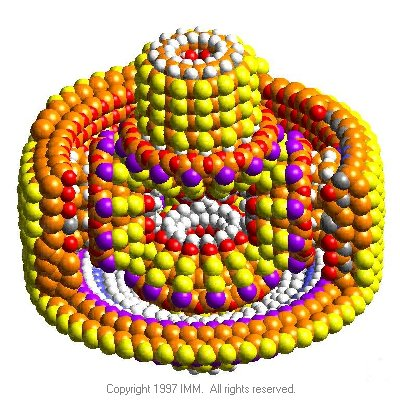
"Molecular Assemblers will bring a revolution without parallel since the development of ribosomes, the primitive assemblers in the cell. The resulting nanotechnology can help life spread beyond Earth - a step without parallel since life spread beyond the seas; it can let our minds renew and remake our bodies - a step without any parallel at all."-Eric Drexler Engines of Creation
In this book, Drexler is credited as being the first person to use the word nanotechnology to describe engineering on the billionth of a meter scale. Though the term was used by Norio Taniguchi in 1974, Taniguchi's use of the word referred to nanotechnology in a different context.[8] Published in 1986, Engines of Creation served to present Drexler's vision of molecular manufacturing that he outlined in his 1981 paper. Essentially, Drexler presented, albeit simplistically, that if atoms are viewed as small marbles, then molecules are a tight collection of these marbles that "snap" together, depending on their chemical properties. When snapped together in the right way, these molecules could represent normal-scaled tools such as motors and gears. Drexler suggested that these "atomic" tools and machines would operate just as their larger counterparts do. The moving parts of the nano-machine (see Figure 4, Drexler's "differential gear") would be formed by many atoms that are held together by their own atomic bonds. Ultimately, in Engines of Creation, Drexler envisioned that these would then be used as "assemblers" that could put together atoms into a desired shape.[9] Applying this simplistic vision of molecular manufacturing, Drexler, in theory, presented that coal can be turned into diamond and computer chips can be created from sand. These processes would occur by using these fabricated atomic tools to reorganize the atoms that make up these materials. Most importantly, from these principles, he sensationally proclaimed in his book that nanotechnology, through the molecular manufacturing of "universal assemblers," would revolutionize everything from biological science to space travel (see quote above). Thus, with both his 1981 publication and his 1986 book, Drexler presented nanotechnology as a scientific field that solely revolved around his own expanded vision of Feynman's molecular manufacturing.[10]
Figure 1.5.
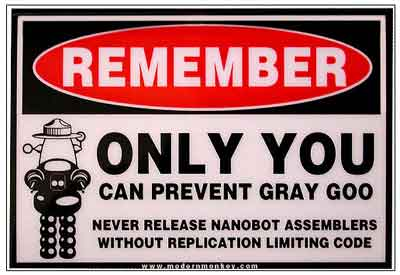
In addition, Engines of Creation also cautions about the possible dangers that accompany this kind of technology. Primarily, Drexler warns of the "gray goo," an amalgamation of self-replicating nanobots that would consume everything in the universe in order to survive (see Figure 5).
This book was highly influential as it brought nanotechnology to the mainstream scientific community for the first time. Though his theories of "gray goo" and molecular manufacturing were later criticized, there is no question that Drexler's work had a profound impact on the establishment of nanotechnology as a scientific field.
The Aftermath of Engines of Creation: Impact and Criticism
Directly after the publication of this book, Drexler founded the Foresight Institute, whose stated goal is to "ensure the beneficial implementation of nanotechnology."[11] Drexler used this "institute" as a way to present his vision of molecular manufacturing that he vividly illustrated in Engines of Creation. Thus, this "institute" was used to further propagate research, through his influential yet highly controversial depiction of nanotechnology and its future.
Figure 1.6.
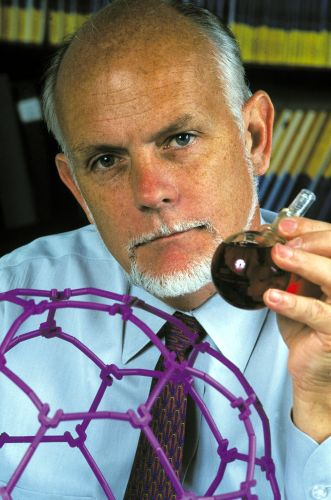
As a result, due to the publicity generated by both Drexler's work and institute, scientists from all over the world began to have a vested interest in the field of nanotechnology. Dr. Richard Smalley (Figure 6), for example, specifically said that he was a "fan of Eric" and that Engines of Creation influenced him to pursue nanotechnology. Moreover, he even gave Drexler's book to the top decision-makers at Rice University. Though criticizing Drexler and his work in future years, Smalley, like other scientists, were intrigued by this book and proceeded to do research in this new and evolving field.[12]
Drexler's vision of molecular manufacturing and assemblers has become, on one hand, a scientific goal, through the Foresight Institute, and, on the other, a controversial issue. Some scientists have criticized Drexler's visions as impossible and harmful. Richard Smalley has led this movement against Drexler's almost sensationalist vision of molecular manufacturing. In their open debate in 2003, Smalley writes almost scathingly, "you cannot make precise chemistry occur as desired between two molecular objects with simple mechanical motion along a few degrees of freedom in the assembler-fixed frame of reference."[13] Furthermore, he also chastises Drexler for his "gray goo scenario" saying, "you and the people around you have scared our children---while our future in the real world will be challenging and there are real risks, there will be no such monster as the self-replicating mechanical nanobot of your dreams."[14] In contrast to Drexler's radical vision, Smalley realistically argued that nanotechnology could be used on a much more practical and attainable level. As a result, due to the onset of academic criticism from scientists such as Richard Smalley, nanotechnology evolved from Drexler's vision of molecular manufacturing to a broad field that encompassed both practical manufacturing and non-manufacturing activities. Chemistry, materials science, and molecular engineering were now all included in this science.
Important Successes in Nanotechnology
In addition to the criticism of Drexler's vision of molecular manufacturing, three important developments that were independent of Drexler's paper helped turn nanotechnology into this broad field, today. First, the Scanning Tunneling Microscope (STM) was invented by Binnig and Rohrer in 1981.
Figure 1.7.

With this technology, individual atoms could be clearly identified for
the first time. Despite its limitations (only conducting materials),
this breakthrough was essential for the development of the field of
nanotechnology because what had been previously concepts were now
within view and testable. Some of these limitations in microscopy were
eliminated through the 1986 invention of the Atomic Force Microscope.
Figure 1.8.
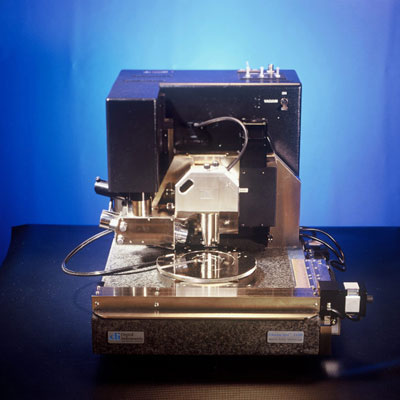
Using contact to create an image, this microscope could image
non-conducting materials such as organic molecules. This invention was
integral for the study of carbon buckyballs, discovered at Rice in 1985-6.[15]
Figure 1.9.
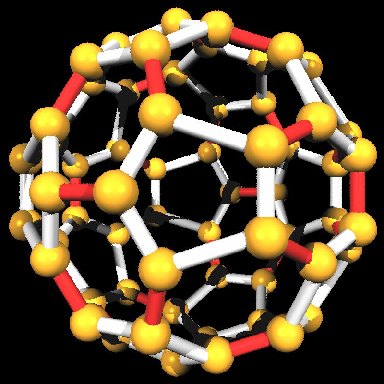
Ultimately, with these two achievements, nanotechnology could develop
through the scientific method rather than through the conceptual and
thus untestable visions of Drexler.
This overall trend created by advancements in microscopy is illustrated through Don Eigler's revolutionary "stunt" at IBM. Here, he manipulated individual Xenon atoms on a Nickel surface to form the letters "IBM."
Figure 1.10.
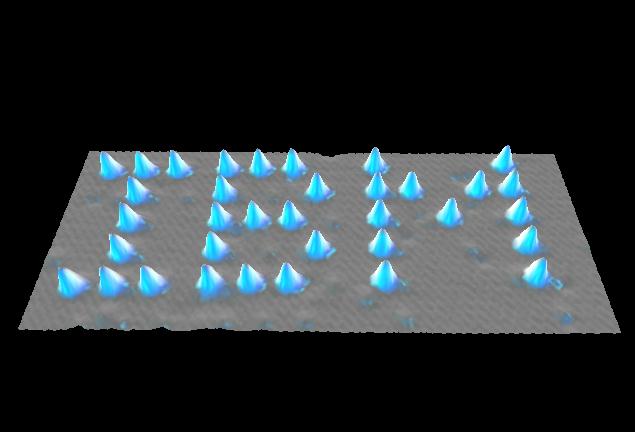
With the microscopy technology that was invented in the early to mid
eighties, Eigler and his research team advanced the field of
nanotechnology by seeking to simply manipulate atoms. Thus, while
Drexler was conceiving sensationalized possibilities of "universal
assemblers," Eigler focused his nanotech research on the realistic and
attainable level that Smalley presented in his argument with
Drexler. From this "stunt," nanotech research followed Eigler's path
and therefore strayed away from Drexler's original vision. Because
nanotechnology was viewed at this level, the field soon encompassed
both practical manufacturing and non-manufacturing activities as
Drexler's ideas were put aside.
Conclusion
While nanotechnology came into existence through Feynman's and then Drexler's vision of molecular manufacturing, the field has evolved in the 21st century to largely include research in chemistry and materials science as well as molecular engineering. As evidenced by Smalley's debate, this evolution is partly a response to the criticism of Drexler's views in both Engines of Creation and the Foresight Institute. Thus, in regards to the development of nanotechnology in the present, Drexler's vision can be viewed as an indirect influence through the sheer interest and subsequent criticism that he created in the field. As Toumey argues, Drexler and therefore Feynman did not have a direct role in the three most important breakthroughs in nanotechnology, the invention of the STM, the invention of the AFM, and the first manipulation of atoms [16]. Instead, Drexler, through Molecular Manufacturing and Engines of Creation, brought scientists from all over the world to the brand new field. Consequently, criticism for Drexler's vision was established by researchers such as Dr. Smalley. Through this reevaluation and the parallel breakthroughs in microscope technology, nanotechnology as a scientific field was established in a way that diverged from Drexler's original vision of molecular manufacturing. This divergence is illustrated through the contrasting goals of the government's National Nanotechnology Initiative (see "Important Links") and Drexler's Foresight Institute. As a result, a thorough grasp of this early history is integral to understanding the development and definition of both the realities and potential of nanotechnology, today. Whereas Drexler created interest in the field but also sensationally outlined a nanotech revolution, researchers around the world have brought the nanotechnology that Drexler first envisioned to a more realistic and attainable level. All in all, today, the goal for nanotech research is not to immediately create billions of assemblers that will revolutionize our world but rather to explore the manufacturing and non-manufacturing aspects of nanotechnology, through a combination of chemistry, materials science, and molecular engineering.17Though places such as Drexler's Foresight Institute remain, academic institutions such as Rice University stay away from Drexler's sensationalized vision of nanotechnology as molecular manufacturing. This divergence is epitomized by the contrasting goals of the U.S government's National Nanotechnology Initiative and the Foresight Institute.
Discussion Questions
What is your take on Toumey's argument against the influence of Feynman's vision? Do you believe that he has it right or do you think that Feynman had a more direct influence on future discoveries? Is his evidence enough?
In his 2004 paper in the Institute of Physics journal Nanotechnology, Drexler slay the grey goo myth he created in Engines of Creation. Is this indicative of a general trend of errors in Drexler's sensationalized vision of molecular manufacturing? Or is this an honest miscalculation in an otherwise plausible theory?
References
[1] Wikipedia, There's Plenty of Room at the Bottom, <http://en.wikipedia.org/wiki/Plenty_of_Room_at_the_Bottom>
[2]Richard Feynman, There's Plenty of Room at the Bottom, Zyvex, <http://www.zyvex.com/nanotech/feynman.html>
[3]Chris Toumey, Apostolic Succession, <http://pr.caltech.edu/periodicals/EandS/articles/LXVIII1_2/Feynman.pdf>
[4]Wikipedia, Eric Drexler, <http://en.wikipedia.org/wiki/K._Eric_Drexler>
[5] Source?
[6]Eric Drexler, Molecular Manufacturing, <http://www.imm.org/PNAS.html>
[7] Ibid.
[8] Wikipedia, Eric Drexler, <http://en.wikipedia.org/wiki/K._Eric_Drexler>
[9]Michael Berry, The Creator, <http://www.sff.net/people/mberry/nano.htm>
[10] Ibid.
[11] Foresight Institute, About the Foresight Institute, <http://www.foresight.org/about/index.html>
[12] Chris Toumey, Apostolic Succession, <http://pr.caltech.edu/periodicals/EandS/articles/LXVIII1_2/Feynman.pdf>
[13] Buam, Rudy. Nanotechnology: Drexler and Smalley make the case for and against ‘molecularassemblers.' Point Counterpoint, Vol.81, number 48, pp.37-41. Chemical and Engineering news. 2003.
[14] Ibid
15Foresight Institute, <http://www.foresight.org/UTF/Unbound_LBW/chapt_4.html>
[16] Chris Toumey, Apostolic Succession, <http://pr.caltech.edu/periodicals/EandS/articles/LXVIII1_2/Feynman.pdf>
[1] 1Applebaum, xi.
[2] 2Hall, p 164
[3] 3Hall, p 166, 167
[4] 4http://www.hfac.uh.edu/gbrown/philosophers/leibniz/BritannicaPages/Descartes/Descartes.html
[5] 5Hall, p 178
[6] 6Hall, p 179
[7] 7http://www.rod.beavon.clara.net/leonardo.htm
[8] 8Hellyer, p 36
[9] 9Set of four rules, http://scienceworld.wolfram.com/biography/Newton.html:
[10] 10Ibid website.
[11] 11Brief History of the Royal Society of London : http://www.royalsoc.ac.uk/page.asp?id=2176
